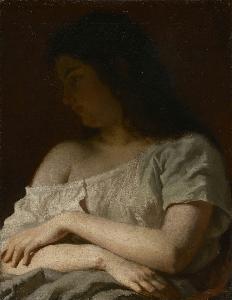Alfredas Izidorius Riomeris
Alfredas Izidorius Riomeris;Alfred Izydor Römer;Alfred Izydor Romer
Place: Vilnius
Born: 1832
Death: 1897
Biography:
Alfred Izydor Römer was a Polish-Lithuanian painter, sculptor, printmaker and medallist from the family of Baltic-German origins. He worked in what is now Lithuania and Belarus. His father was Edward Jan Römer, a painter, writer and social activist. His grandfather was Michał Józef Römer, a politician who favored the abolition of serfdom.
Early Life and Education
Alfred Izydor Römer was born in 1832 in Lithuania. He studied drawing with Kanuti Rusiecki in Vilnius. In 1850, he went to Vologda, where his father was exiled in 1839. They both returned to Vilnius in 1852, and Alfred Izydor opened a painting academy.
Career
Alfred Izydor Römer traveled to Europe with Jan Zienkiewicz in 1857, visiting Dresden, Paris, Belgium, and Italy. He returned home and settled in Krewno estate in Ukmergė County. He also contributed prints and drawings of rural life to a Polish illustrated magazine called Kłosy (Ears of Wheat). In 1863, he was arrested and imprisoned at Dinaburg Fortress for organizing the uprising in Lithuania.
Artistic Style
Alfred Izydor Römer's artistic style is characterized by his use of oil on canvas. His paintings are known for their realism and attention to detail. He was influenced by the Polish-Lithuanian art movement, which emphasized the use of traditional techniques and materials.
Notable Works
Some of Alfred Izydor Römer's notable works include The Stirling Smith Art Gallery and Museum, which is a collection of paintings and sculptures. He also created Medieval Art reproductions, which are available on Wikioo.org. His Romanticism style is evident in his paintings, such as A Battle, which is a stunning representation of a dramatic scene.
- Thomas Stuart Smith was another artist who influenced Alfred Izydor Römer's work.
- Peter Thomson was also an artist who worked with Alfred Izydor Römer.
- Thomas Faed was a Scottish artist who created Romanticism paintings.
Legacy
Alfred Izydor Römer's legacy is evident in his contributions to the Polish-Lithuanian art movement. His use of traditional techniques and materials has influenced many artists, including those who work with Wikioo.org. His realism and attention to detail have made his paintings a staple in the art world. In conclusion, Alfred Izydor Römer was a talented artist who contributed significantly to the Polish-Lithuanian art movement. His use of traditional techniques and materials has influenced many artists, and his legacy continues to be celebrated through his paintings.

